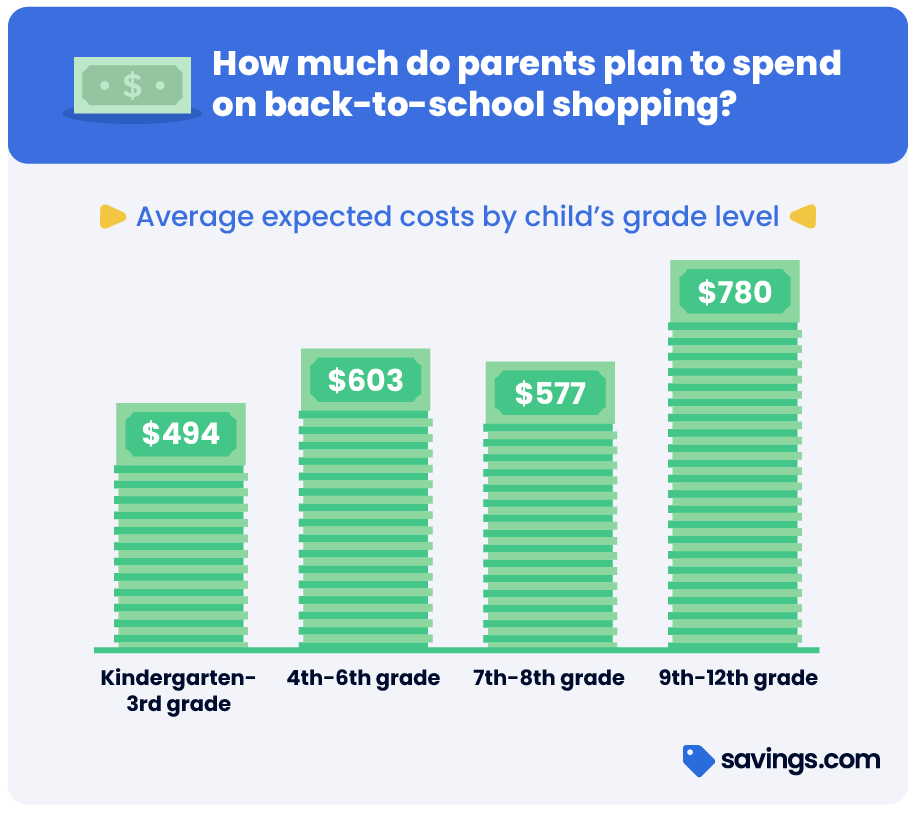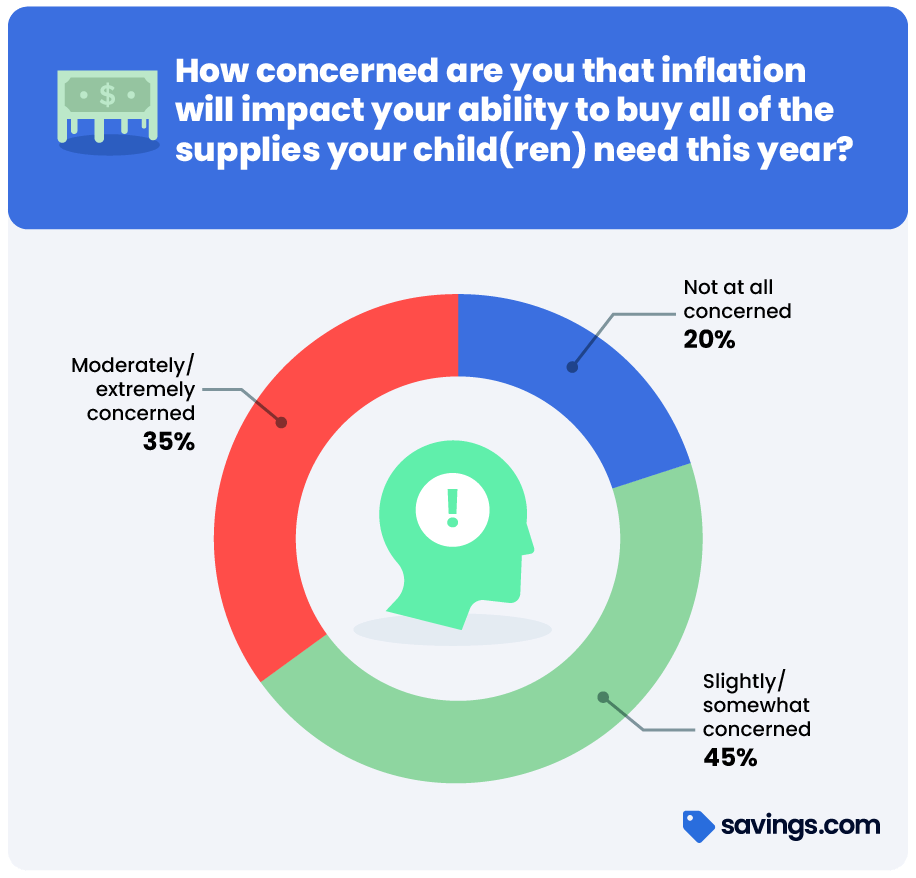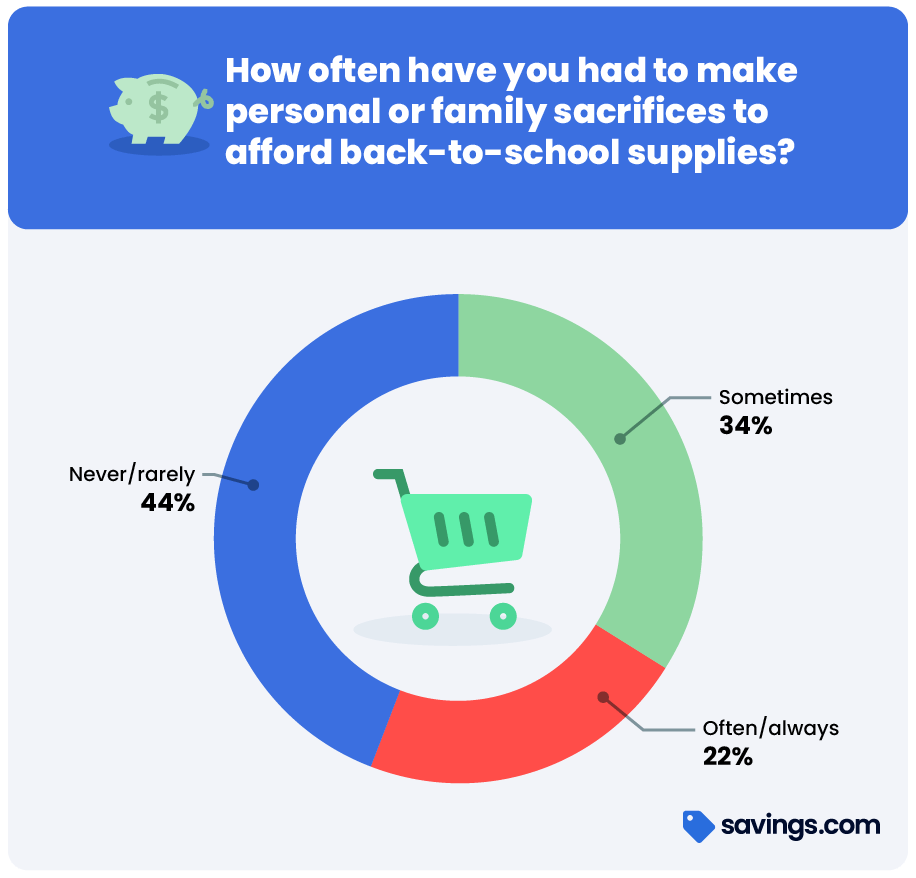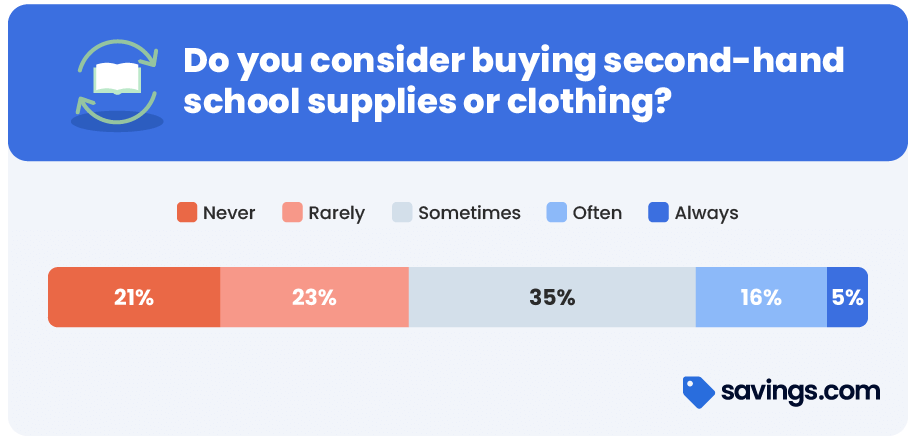
Last Updated: July 29, 2024
54% of families expect to spend more on back-to-school shopping this year than last, at about $605 per student
Lingering inflation and low consumer confidence will make this back-to-school shopping season incredibly stressful. Families will spend over $600 per child ahead of the upcoming semester. Taking advantage of retailer sales, community assistance programs, and state tax holidays will be more critical than ever for balancing tight budgets.
The research team at Savings.com surveyed more than 1,200 parents of school-aged children to better understand their families’ back-to-school burdens while gathering their savviest shopping tips.
Key Findings:
- Most families plan to spend more on back-to-school shopping in 2024 than last year – 8 in 10 blame inflation for the increasing expenses.
- Parents will spend an average of $605 per child on new school clothing and supplies, ranging from $494 for elementary students to $780 for high schoolers.
- Clothing will be the most significant back-to-school expense, costing around $231 per child.
- 56% of parents are making personal sacrifices to afford their kids’ school expenses. More than 40% of families will postpone or skip school supply purchases due to cost concerns.
- 54% of parents plan to save by shopping during their state’s tax-free holidays, and 37% plan to seek financial assistance for their kids’ school costs.
Back-to-School Blues: Student Expenses Higher than Ever
Getting your children ready for classes involves a wide range of expenses. Back-to-school necessities go beyond clothing and classroom supplies, including medical appointments, haircuts, digital tech, and backpacks to keep everything organized. Unfortunately, the costs for nearly everything on school shopping lists have risen. According to our latest research, more than half of families with kids heading back to class this fall anticipate higher costs this year, with nearly a quarter expecting to spend much more. 

| Per household spending range on school supplies | |
|---|---|
| $0 - $199 | 8% |
| $200 - $399 | 21% |
| $400 - $599 | 19% |
| $600 - $799 | 13% |
| $800 - $999 | 10% |
| $1000+ | 29% |
As students advance in their learning, so do costs. High schoolers' parents plan to spend $780 on their back-to-school shopping lists. In contrast, school shopping for elementary-aged students is expected to cost under $500. Some high schoolers need specialized items like graphing calculators, advanced textbooks, and lab equipment, often more expensive than the basic supplies required for younger students. High school students might also need laptops or tablets, further driving up costs.
Clothing is the most expensive item on most back-to-school shopping lists. Whether keeping up with fashion trends, accommodating growing youths, or complying with new uniform requirements, parents will spend an average of $231 per child on threads alone—more than one-third of their back-to-school budgets. Retailers like The Children’s Place and Old Navy try to relieve the cost burden by offering deals on uniforms and casual clothes during back-to-school shopping season.
| Average per-child spending on back-to-school items | |
|---|---|
| Clothing | $231 |
| Electronics | $103 |
| Basic school supplies | $87 |
| Backpacks | $49 |
| Haircuts | $39 |
| Checkups/doctor visits | $28 |
| Shared classroom supplies | $30 |
| Other costs | $38 |
Clothing expenses increase with age as a sense of style and peer pressure become part of adolescent life. Wardrobe upgrades for high school seniors will be the most expensive ($316), and first-graders will be the least costly ($173).
With parents tightening their belts to buy new belts for their kids, what are some ways to make back-to-school shopping more affordable?
Back-to-School Savings Strategies and Tips
Parents work hard to provide for their children, but inflation means the same income buys less. Higher prices stretch household budgets, forcing difficult decisions and sacrifices. Four out of five families worry that inflation will make some school supplies unaffordable, with one-third strongly concerned about the impact on their buying power.
Forty-two percent of back-to-school shoppers have already cut certain items off their school supply lists to save money. Others told us they’d reuse serviceable items like backpacks, and some are delaying new clothing purchases until the next season to spread out costs and wait for better deals.
These cutbacks reflect the budgetary strain caused by school shopping. Eighty-four percent of families say that back-to-school expenses will somewhat stress their finances. Nearly one in five told us that stress would be high or extreme.
Beyond financial stress, monetary apprehension creates anxiety and impacts mental health – the last thing parents need when dealing with back-to-school pressure. This drove us to ask American families for their best tips for managing back-to-school shopping.
| What is the single best piece of advice you have for saving money on back-to-school shopping? | |
|---|---|
| Shop sales and discounts | 45% |
| Budget and plan ahead | 25% |
| Reuse and repurpose | 15% |
| Buy generic or secondhand | 10% |
| Seek community assistance programs | 5% |
1. Shop sales and take advantage of tax savings
Parents’ primary advice was vigilant bargain-hunting, which is a sound strategy. They recommend starting their school-related shopping early and seeking deals throughout the season. Many retailers have already launched back-to-school sales . Additionally, numerous states feature summer sales tax holidays (designated periods when sales tax is not collected on certain items), which can save parents an extra five to 10 percent while stocking up on essentials.| Back-to-school sales tax holidays state-by-state guide | ||
|---|---|---|
| State | 2024 Dates | Covered items* |
| Alabama | July 19 - 21 | Clothing, footwear, supplies, electronics |
| Connecticut | August 18 – 24 | Clothing, footwear |
| Florida | July 29 – August 11 | Clothing, footwear, computers, learning aids, supplies |
| Iowa | August 2 - 3 | Clothing, footwear |
| Maryland | August 11 – 17 | Clothing, footwear, backpacks |
| Massachusetts | August 10 – 11 | Most personal retail items |
| Mississippi | July 12 – 14 | Clothing, footwear, supplies |
| Missouri | August 2 – 4 | Clothing, computers, supplies |
| New Mexico | August 2 – 4 | Clothing, computers, supplies |
| Ohio | July 30 – August 8 | Most tangible personal property |
| Oklahoma | August 2 – 4 | Clothing, footwear |
| South Carolina | August 2 – 4 | Clothing, footwear, computers, printers, supplies |
| Tennessee | July 26 - 28 | Clothing, footwear, computers, supplies |
| Texas | August 9 – 11 | Clothing, footwear, backpacks, supplies |
| Virginia | August 2 – 4 | Clothing, footwear, supplies |
| West Virginia | August 2 – 5 | Clothing, footwear, computers, supplies, instructional material, sports equipment |
Fifty-four percent of parents in our study said they’d take advantage of tax holidays ahead of the upcoming school year. Several other states (Delaware, Massachusetts, Minnesota, Montana, New Hampshire, New Jersey, New York, Pennsylvania, Rhode Island, Oregon, and Vermont) exempt most clothing purchases from sales tax year-round. If one lives near a consumer-friendly territory, shopping across the border can save a few bucks (but beware that your home state may charge a use tax on the purchases).
2. Budget and make a shopping plan
One-quarter of surveyed parents emphasized the importance of planning and budgeting for back-to-school shopping. Their most common advice included putting aside a little money each month so that expenses don’t wallop one’s wallet all at once. Many mentioned that setting a spending limit and sticking to it helped prevent overspending or impulsive splurges.
For others, planning for back-to-school costs also meant making personal sacrifices – cutting back on other expenses or adding extra work hours. More than half of parents have made sacrifices to accommodate back-to-school spending, and one in five do so “always" or “often."
The most common ways families reduce expenses include eating out less and trimming entertainment costs (like cutting some streaming services). Those who still needed extra money for school shopping mentioned working extra shifts, taking on second jobs, or finding freelance gigs.
3. Reuse and repurpose supplies
This popular approach to handling school expenses prioritizes practicality and sustainability. Reusing and repurposing supplies from previous years (or from older siblings) eliminates waste and saves money.
This patient approach can be advantageous for electronic devices and gadgets. Though manufacturers release new models of laptops, tablets, and other gear every year, upgrading is rarely imperative. Most parents realize that usage cycles for expensive electronics can be extended without leaving students behind—only 17 percent feel it’s essential for kids to have the latest digital iterations.
Some families that can’t reuse their own clothes and supplies said they sell them to offset the costs of new supplies. That ties in nicely with the next tip.
4. Shop generic or secondhand
Some status-conscious students may be wary of second-hand or off-brand supplies, but parents realize that dollars go much farther with used or generic goods. Most families buy second-hand school clothing or supplies at least some of the time, and one in five households do so “often" or “always."
Luckily for frugal families, shopping for second-hand clothes (marketed more appealingly as “thrifting" for “vintage" threads) has become chic among Gen Zers, with teens even selling used outfits to each other online.
Generic brands may be less popular with kids, but they make sense to parents and their purse strings. One-third of families mostly or always buy generic school supplies, and another third lack preferences for name brands.
| Do you prefer to buy brand-name school supplies or generic options? | |
|---|---|
| Mostly/always generic | 30% |
| No preference | 38% |
| Mostly/always brand name | 32% |
Opting for generics often strikes a sensible balance between quality and affordability, ensuring that students have what they need, whether it’s flashy or not. For example, Walmart’s Pen+Gear brand offers a large selection of fashionable and affordable school supplies, and so does Target’s Up and Up brand.
5. Seek out community assistance and aid programs
Though most saving methods require families to look inward — employing budgets, cost-cutting, and sacrifices — side aid is also available for families who know where to look. More than one-third of families will seek some form of financial assistance ahead of the next school year, and free lunch was the most popular form of aid. Other parents plan to seek out aid for backpacks and supplies, clothing, and even haircuts or doctors’ visits.
Several national organizations feature back-to-school support programs, including The Boys and Girls Clubs of America, the Kids in Need Foundation, the Assistance League, and Operation Homefront (catering to children in military families). Internet searches and news stories can locate local groups sponsoring giveaways of backpacks, supplies, and clothes. Some school districts and teacher unions also host back-to-school fairs supplying students with haircuts and health checks free of charge.
After sharing great money-saving tips ahead of the next semester, our parents offered one more poignant piece of advice: families shouldn’t forget to splurge a little. Heading back to school is also stressful for students, so boosting confidence and style with a bit of indulgence can help keep kids' spirits high.
More than two-thirds of families splurge on at least one item, and most often, it's shoes and clothing.
| Which back-to-school items do you splurge on? | |
|---|---|
| Footwear | 25% |
| Clothing | 20% |
| Backpacks | 15% |
| Technology | 7% |
| Other | 2% |
| None | 31% |
Parents credited brand-name splurges as both personal and practical. Higher-quality goods could make kids feel more confident, and they often prove more durable (so they needn’t be replaced and may be handed down). Top-rate backpacks were specifically credited with resisting rips and being more comfortable. Parents who splurged on electronic devices expressed hope that the investment would pay off with better grades.
Conclusion
Families facing financial strain know it's never too early to start saving money. Summer vacation just began for some, but back-to-school bargains already abound.
As unrelenting inflation drives school supply expenses higher, most parents will spend more this year than last. For fall 2024, school supply costs will exceed $600 per child, climbing to $850 for high school seniors.
Skyrocketing prices stress family finances and force parents to be more resilient and resourceful. Some cut entertainment expenditures, others work extra hours, and all search for ways to spend more wisely. Setting strict budgets, seeking out sales, using sales tax holidays, buying second-hand, and sensibly reusing supplies can all help stretch dollars.
As always, Savings.com will do its part by staying ahead of the curve and bringing you all the best back-to-school bargains.
Our Data
We surveyed 1125 U.S. adults with K-12 children in the 2024-2025 school year; our survey was conducted online in June 2024. The median annual income of the families in our study was between $70,000 and $80,000.
In the fall of 2024, 50% of respondents will have one child attending K-12 school, 36% have two, 11% have three, and 3% have four or more children.
Parents in the study represent 1,904 children. 691 will attend Kindergarten, 448 will attend grades 4th-6th, 273 will attend grades 7th-8th, and 492 will attend grades 9th-12th
72% of children in our study attend public school, 12% attend private or religious schools, 12% attend homeschool or online virtual school, and 4% did not disclose the type of school.






